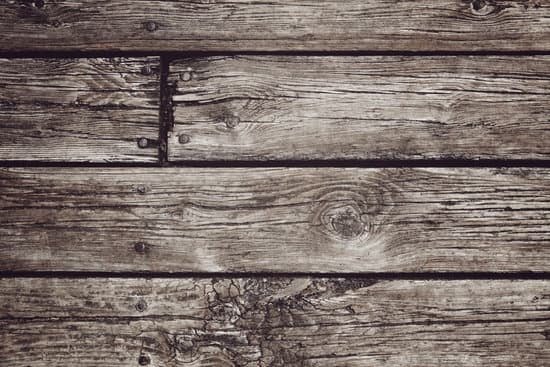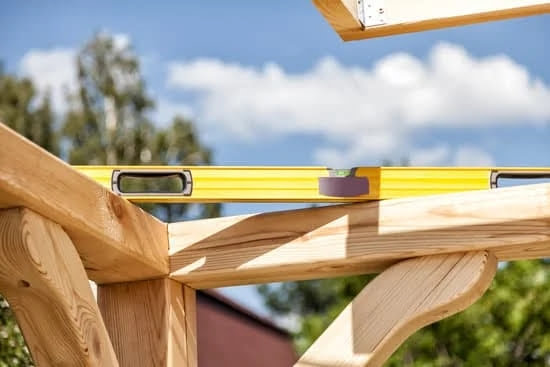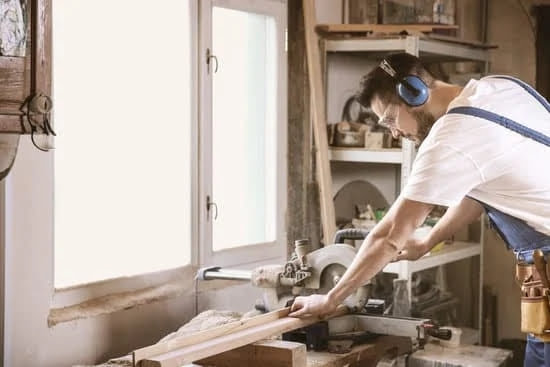Woodworking is a timeless craft that has been valued across various industries and hobbies for centuries. It involves the art of shaping and manipulating wood to create functional and aesthetic pieces that range from furniture to intricate sculptures.
Central to the practice of woodworking is the use of planes, which are essential tools in achieving precise wood shaping. In this article, we will explore what a plane is in woodworking, its origins, anatomy, different types, how to choose the right one for your project, proper setup and maintenance, effective techniques and tips for using a plane, common challenges and troubleshooting, as well as inspiring projects showcasing the use of planes in woodworking.
Planes have played a crucial role in woodworking throughout history. From ancient civilizations to modern times, these tools have continuously evolved from simple hand tools to more complex machinery. Understanding the origins of planes can provide valuable insights into their development and how they have become vital instruments in the world of woodworking.
To dive deeper into planes in woodworking, it is important to understand their anatomy. Each part of a plane has its own purpose and function that contributes to achieving precise wood shaping. By examining the body, blade, frog, and handles of a plane, we can gain a comprehensive understanding of how these components work together harmoniously.
Once familiar with the anatomy of a plane, it becomes essential to explore the different types available in woodworking. Bench planes for general-purpose work, block planes for end grain or trimming tasks, joinery planes for more specialized applications – each type exhibits unique characteristics catered towards specific woodworking needs. Knowing which type to use can elevate your craftsmanship significantly while saving time and effort.
As you embark on your journey through this article about woodworking planes, prepare yourself for an intriguing exploration encompassing history, functionality, selection criteria adjustment techniques troubleshooting advice fool-proof recommendations plus project inspiration galore Find out all there we go plans will ever need efficiently shape any splendid piece magnificent woodwork ever lay eyes upon.
Origins of the woodworking plane
The origins of the woodworking plane trace back thousands of years to ancient civilizations. The earliest evidence of planes being used in woodworking can be found in ancient Egyptian tombs, where wooden planes have been discovered alongside other tools and artifacts. These early planes consisted of a simple wooden body with a blade securely held in place. They were primarily used for smoothing and shaping wood surfaces.
As woodworking techniques evolved, so did the design and functionality of planes. In the Middle Ages, European craftsmen began using more specialized planes, such as molding planes for creating decorative profiles and rabbet planes for making precise grooves and rebates. These planes were often highly intricate and required skilled craftsmanship to create.
In the 18th century, with the advent of industrialization, hand woodworking tools started to be mass-produced using machinery. This allowed for greater precision and consistency in plane manufacturing. At this time, metal bodies began replacing wooden ones, offering increased durability and stability.
Today, modern woodworking planes are available in a variety of designs, materials, and sizes. Some handplanes are still made entirely by hand using traditional methods, while others incorporate advanced technology like adjustable blades and ergonomic handles. Whether it’s a traditional wooden-bodied plane or a high-tech machinery-assisted one, the evolution of the woodworking plane continues to enhance its effectiveness and versatility in achieving precise wood shaping.
Understanding the anatomy of a woodworking plane
The Body
The body of a woodworking plane is the main component that holds all the other parts together. It is typically made of wood or metal and is designed to provide stability and control during use. The body has a flat surface called the sole that glides over the wood, allowing for smooth and even planing. The length of the body can vary depending on the type of plane, with longer bodies for larger projects requiring more surface area coverage.
The Blade
The blade, also known as the iron or cutter, is arguably one of the most important parts of a woodworking plane. It is usually made of high-quality steel and needs to be sharp to effectively cut through the wood fibers. The blade is securely held in place by a chip breaker or cap iron, which helps reduce tear-out by breaking up wood fibers before they reach the cutting edge.
The Frog and Adjusting Mechanisms
The frog is a key component located inside the body of a plane, responsible for holding the blade at a specific angle relative to the sole. It provides adjustability to achieve different depths of cut by sliding forward or backward along an inclined track. The frog can be adjusted using screws or levers to change the distance between the cutting edge and the mouth of the plane, ultimately affecting the thickness of shavings taken.
Most planes also come equipped with various adjusting mechanisms to fine-tune their performance. These include lateral adjustment levers for aligning the blade laterally across its width, depth adjustment knobs for controlling how much of it protrudes below the sole, and sometimes even additional features like Norris-style adjusters that enable precise control over these adjustments.
The Handles
Woodworking planes generally have two handles – one near the front (tote) and another towards behind (knob). These handles provide grip and control while guiding and maneuvering the plane along the wood surface. They are often ergonomically shaped to fit comfortably in the hand, allowing for extended periods of use without straining the user’s wrists or hands.
Understanding the anatomy of a woodworking plane is crucial for mastering its use and achieving precise wood shaping results. Each component plays a vital role, working together harmoniously to create smooth finishes, accurate dimensions, and intricate profiles. Now that we have explored the different parts of a woodworking plane, let’s delve into the various types of planes used in woodworking in the next section.
Different types of woodworking planes
Woodworking planes come in various types, each with its own unique characteristics and applications. Understanding the different types of planes is essential in selecting the right tool for specific woodworking tasks. Here are some of the most commonly used types of woodworking planes:
- Bench Planes: Bench planes are versatile and commonly used for general-purpose work. They are available in different sizes, with the number representing their length. Smaller bench planes, such as No. 3 or No. 4, are great for smoothing surfaces and removing small imperfections. Larger bench planes, like No. 5 or No. 7, are ideal for flattening large surfaces or quickly removing wood.
- Block Planes: Block planes are smaller hand-held planes that can be easily maneuvered with one hand. They have a low-angle blade and are designed for end grain work, chamfering edges, and trimming small pieces of wood. The compact size makes block planes perfect for working in tight spaces or delicate projects.
- Joinery Planes: Joinery planes specialize in creating precise joints and fitting pieces together accurately. Examples include shoulder planes, rabbet planes, and dado planes. These specialized tools help achieve tight-fitting mortise and tenon joints or create grooves for joinery work.
In addition to these main types, there are other specialized woodworking planes like moulding planes (for decorative profiles), rebate planes (for rebating or cutting recesses), and plough planes (for creating grooves along a wood piece). It’s important to select the right type of plane based on your specific project requirements to ensure optimal results.
When choosing a woodworking plane, consider factors such as the type of wood you’re working with, desired finish quality, and task at hand. Lightweight block planes may be preferable for handheld work on delicate projects, while larger bench or joinery planes may be better suited for heavy-duty tasks that require more force and precision. Experimenting with different types of planes can help you find the best tool for each woodworking project, leading to better results and increased efficiency.
How to choose the right plane for your project
When embarking on a woodworking project, it is essential to choose the right plane for the task at hand. Selecting the appropriate plane can greatly impact the efficiency and quality of your woodworking results. Here are some factors to consider when choosing a plane for your project:
Type of Wood
Different types of wood have varying characteristics, such as hardness or grain pattern, that can affect how they respond to different planes. For softer woods like pine or cedar, a smoother plane may be more suitable for achieving a fine finish. On the other hand, harder woods like oak or maple may require a heavier-duty plane, such as a jack plane, to tackle their density.
Desired Finish
Consider the specific finish you want to achieve for your project. If you aim for a smooth surface with no visible tool marks, a smoothing plane is ideal.
This type of plane has a shorter sole length and a finely set blade that cuts thin shavings, leaving behind an incredibly smooth surface. However, if you are looking to remove larger amounts of material quickly or create specific profiles and shapes, you might opt for other types of planes, such as block planes or joinery planes.
Specific Task Requirements
Understanding the requirements of your woodworking task will help guide your choice of plane. For example:
- If you need to flatten large surfaces like tabletops or cabinet doors, a longer bench plane with a wider blade will provide stability and cover more area.
- For delicate tasks like trimming end grain or fitting joints precisely, block planes with adjustable mouth openings are excellent choices.
- When working on intricate details or shaping moldings and edges, specialized planes like shoulder planes or rabbet planes can offer precision and control.
Considering these factors will lead you towards selecting the most suitable plane for your project. It is worth noting that having multiple types of planes in your workshop can give you more versatility and flexibility in tackling different woodworking tasks. Experimenting with various planes will help you discover the ones that best suit your woodworking style and allow you to achieve the desired results for each unique project.
Proper plane setup and maintenance
The proper setup and maintenance of a woodworking plane are crucial for achieving optimal performance and longevity. A well-maintained plane can help ensure smooth and precise wood shaping, while also preventing issues such as tear-out or inefficient cutting. This section will outline the essential steps for setting up a plane correctly and offer tips on maintaining its condition.
One of the first steps in setting up a plane is adjusting the blade. The blade should be centered in the mouth of the plane, protruding slightly from the sole.
This can be achieved by loosening the lever cap or cap iron, sliding the blade forward or backward to achieve the desired position, and then tightening it securely. It is important to pay attention to the angle at which the blade sits in relation to the sole of the plane-known as the blade’s pitch-and adjust it accordingly for optimal cutting performance.
Another crucial aspect of plane setup is ensuring that the sole is flat. A flat sole ensures even contact with the surface being planed, resulting in smoother cuts and avoiding any dragging or rocking motion during use. Woodworkers often check for flatness by using a straight edge or a precision leveling tool. If any areas are found to be uneven, they can be carefully filed or sanded down until flat.
Additionally, maintaining a sharp blade is vital for achieving clean cuts with minimal tear-out. Regular sharpening should be incorporated into a woodworker’s routine to keep blades in top condition. Numerous sharpening techniques exist, ranging from oil stones to diamond stones and honing guides. Experimenting with different methods can help identify which technique works best for individual preferences.
| Step | Description |
|---|---|
| Blade Adjustment | Center the blade in the mouth of the plane and adjust its position for optimal cutting performance. |
| Sole Flatness | Ensure that the sole of the plane is flat to achieve even contact and smoother cuts. |
| Blade Sharpening | Maintain a sharp blade by regularly sharpening it using appropriate techniques and tools. |
By following these steps, woodworkers can set up their planes correctly and keep them well-maintained, ensuring consistent performance and longevity. Taking the time to properly care for woodworking planes not only helps achieve better results but also allows woodworkers to fully appreciate the craftsmanship and versatility that these tools offer.
Techniques and tips for using a woodworking plane effectively
Woodworking planes are essential tools for achieving smooth and precise results. Whether you’re smoothing rough surfaces, dimensioning lumber, or creating intricate profiles, using a woodworking plane effectively requires employing proper techniques and following useful tips. This section will provide you with valuable insights on how to get the most out of your plane and achieve consistent woodworking success.
Fundamental Techniques for Using a Woodworking Plane
One of the fundamental techniques in using a woodworking plane is smoothing. Smoothing involves removing any imperfections or roughness from the surface of the wood to achieve a glass-like finish. To do this, start by adjusting the blade depth to take off thin shavings rather than deep cuts.
Apply firm but even pressure while pushing the plane forward in smooth strokes along the grain direction. Be sure to overlap each pass slightly to ensure even coverage across the entire surface.
Another important technique is dimensioning, which refers to reducing stock thickness or width to achieve specific dimensions. When dimensioning with a plane, it’s crucial to work methodically and precisely. Begin by marking your desired measurements on the wood and use a combination square for accuracy.
Adjust the blade depth according to your desired outcome, keeping in mind that taking off too much material at once can result in uneven surfaces or tear-out. Work in shallow passes, applying consistent pressure while guiding the plane along the grain until you reach your target dimensions.
Creating different profiles is another aspect where woodworking planes excel. By adjusting the blade angle or using specialty planes such as molders or rabbet planes, you can shape edges, create bevels and chamfers, or carve decorative details onto your wooden pieces. Each profile requires a different approach and technique, so it’s essential to practice on scrap wood first until you become comfortable with manipulating the plane to achieve desired results.
Expert Tips for Achieving Smooth and Precise Results
To ensure optimal performance and achieve smooth, tear-free cuts, keep the following tips in mind:
- Maintain a sharp blade: A sharp blade is crucial for clean cuts and reducing tear-out. Regularly sharpen your plane blades using sharpening stones or honing guides to maintain optimal sharpness.
- Control grain direction: Pay attention to the grain direction of the wood you’re working with, as planing against the grain can cause tear-out. Always work with the grain for smoother results.
- Practice proper stance and body mechanics: To achieve precision and avoid fatigue, adopt a stable stance with feet shoulder-width apart and align your body with the direction of the plane’s stroke. Apply even pressure throughout each stroke while maintaining balance.
By employing these fundamental techniques and implementing expert tips, you can use a woodworking plane more effectively and achieve smoother, more precise woodworking outcomes. Remember, practice makes perfect. Don’t be afraid to experiment and refine your skills to unlock the full potential of this versatile tool.
| Technique | Tips |
|---|---|
| Smoothing | – Adjust blade depth for thin shavings
|
| Dimensioning | – Mark desired measurements on wood
|
| Creating profiles | – Adjust blade angle or use specialty planes
|
Common challenges and troubleshooting with woodworking planes
Woodworking planes are essential tools in the woodworker’s arsenal, allowing for precise shaping and smoothing of wood surfaces. However, like any tool, they can present their own set of challenges. Understanding and troubleshooting these challenges is crucial for achieving the best results with your woodworking projects.
One common challenge that woodworkers may encounter when using a plane is tear-out. Tear-out refers to the occurrence of wood fibers tearing out instead of being smoothly cut by the blade, resulting in an uneven surface. This issue can be particularly frustrating when working with figured or curly woods. To minimize tear-out, there are several techniques you can employ.
First, it is important to ensure that your plane’s blade is sharp and properly honed. Dull blades are more likely to cause tear-out as they struggle to cleanly cut through the fibers. Additionally, adjusting the blade angle can make a significant difference in reducing tear-out. By increasing the angle at which the blade meets the wood surface, you can minimize the chances of fibers being torn out.
Another challenge that woodworkers may face is dealing with dull blades. Dull blades not only lead to poor cutting performance but can also cause tear-out and leave unsightly marks on the wood surface. It is essential to regularly sharpen and maintain your plane’s blades to achieve optimal results. There are various methods for sharpening blades, including using water stones or honing guides. Whichever method you choose, consistency and attention to detail are key in achieving a sharp edge.
Improper plane setup is another challenge that can hinder woodworking success. Ensuring that your plane is set up correctly involves several factors such as adjusting the depth of cut, ensuring flat soles, and aligning the frog properly. If any of these elements are off-kilter, it can result in inefficient cutting or inaccurate shaping. Taking the time to properly set up your plane before each use will greatly enhance your woodworking experience and the quality of your work.
By understanding and troubleshooting these common challenges in woodworking plane usage, woodworkers can overcome obstacles and achieve outstanding results in their projects. Experimentation, practice, and attention to detail are key strategies for mastering the use of planes and unlocking their full potential in shaping wood.
Inspiring projects showcasing the use of planes in woodworking
Woodworking planes are versatile tools that play a significant role in shaping wood and creating stunning projects. From intricate designs to functional furniture pieces, the use of planes in woodworking can result in remarkable craftsmanship. Here are some inspiring projects that showcase the capabilities and artistry involved in using planes:
One such project is the creation of a handcrafted wooden bowl. By using a combination of block planes and joinery planes, woodworkers can shape the raw material into a beautifully curved bowl.
The precise adjustments made with the plane’s blade allow for smooth finishes and refined details on the surface of the bowl. This project not only demonstrates the skill required to work with planes but also highlights how these tools can transform a simple piece of wood into an exquisite functional object.
Another inspiring example is the construction of intricate wooden furniture. From chairs to tables, woodworking planes are essential in achieving precise cuts, joint fittings, and shaping design elements. Using bench planes, woodworkers can flatten surfaces and create accurate dimensions, ensuring seamless joints for structural stability. With meticulous attention to detail and proper technique, these furniture pieces become works of art that reflect both style and functionality.
Woodworking planes are also prominently used in creating unique decorative features like moldings or ornamental carvings. By selecting appropriate joinery or molding planes, artisans can create intricate patterns that enhance the aesthetic appeal of any woodworking project. These delicate details often require specialized profiling planes, which allow craftsmen to shape wood precisely according to their desired design. The use of these planes adds depth and character to otherwise ordinary pieces and transforms them into visually captivating works.
Conclusion
In conclusion, woodworking planes play a vital role in the world of woodworking, providing woodworkers with the ability to shape and transform wood into beautiful and functional pieces. Throughout history, planes have evolved from basic hand tools to more advanced machinery, allowing for greater precision and efficiency in wood shaping. Understanding the anatomy of a plane is essential, as it helps woodworkers utilize each component effectively to achieve desired results.
There are various types of woodworking planes available, each with its unique characteristics and applications. Choosing the right plane for a project depends on several factors such as the type of wood being used, desired finish, and specific task requirements. By selecting the appropriate plane for a particular project, woodworkers can greatly enhance their efficiency and produce high-quality results.
Proper setup and maintenance of a woodworking plane are crucial for achieving optimum performance. Blades should be adjusted correctly, soles should be flat, and sharpening techniques should be employed regularly. Regular maintenance not only prolongs the lifespan of the plane but also ensures consistent and precise woodworking outcomes.
Woodworking planes come with their set of challenges, from tear-out to dull blades or improper setup. However, these can be overcome with troubleshooting advice and practical solutions. By addressing common issues head-on, woodworkers can continue to refine their skills and craftsmanship.
Lastly, inspiring projects that incorporate planes in woodworking demonstrate the endless possibilities that come with using these tools. From creating intricate profiles to achieving smooth finishes or dimensioning rough lumber, planes allow for creativity to flourish in woodworking endeavors.
Frequently Asked Questions
What are the different types of planes in carpentry?
In carpentry, there are various types of planes that serve different purposes. One common type is the bench plane, which comes in different sizes and is used for general woodworking tasks such as smoothing rough surfaces, fitting joints, and trimming doors or windows. Another type is the block plane, which has a compact size and is designed for working on end grain or small-scale projects like chamfering edges or shaping small parts.
A shoulder plane is specifically crafted for fine-tuning joints and leveling shoulders, while a rebate or rabbet plane is suitable for creating recesses or grooves along the edge of a piece of wood. Lastly, there are specialty planes like the plow plane used for cutting grooves parallel to an edge and the router plane used for flattening surfaces or removing material to a specific depth.
What is a plane used for?
A plane is an essential woodworking tool used for shaping and smoothing wooden surfaces. It consists of a sharp blade (also called an iron) set within a sturdy body (or stock), typically made from metal or wood. The primary purpose of using a plane in carpentry is to remove thin shavings from a workpiece’s surface, reducing high spots and leaving behind smooth and even results.
Planes can be used to flatten rough lumber, level out uneven boards, create flat tabletops or joint edges for seamless connections in cabinetry or joinery. They can also be employed to achieve specific decorative effects by shaping profiles or adding bevels along the edges.
What do woodworking plane numbers mean?
Woodworking plane numbers generally refer to the length and width of the blade in inches. These numbers help categorize and differentiate between various sizes of planes available in the market, allowing craftsmen to choose the most suitable tool for their specific needs. For instance, a No. 4 bench plane typically has a blade that measures around 2 inches wide by 9-10 inches long, whereas a No. 5 would have a slightly wider blade at around 2.25 inches.
The larger the number, the wider and longer the blade becomes. Woodworkers often select plane numbers based on the scale of their projects; smaller planes like No. 1 or No. 2 are handy when working on intricate details or delicate pieces, while larger planes offer more efficiency and coverage for bigger tasks.

Hi everyone! I’m a woodworker and blogger, and this is my woodworking blog. In my blog, I share tips and tricks for woodworkers of all skill levels, as well as project ideas that you can try yourself.





